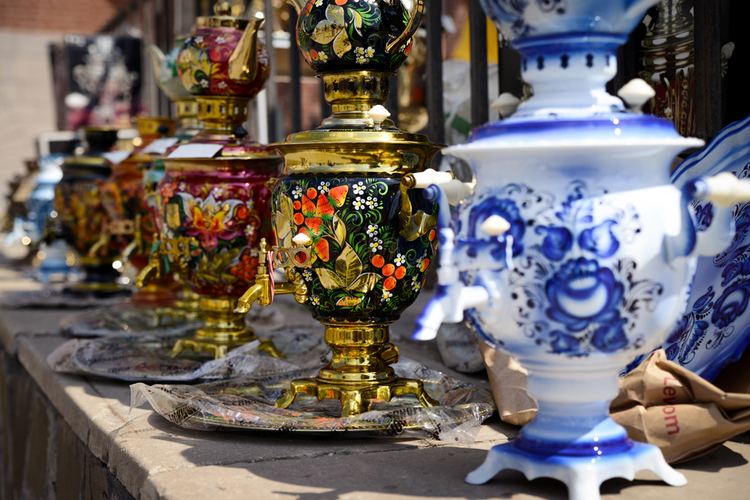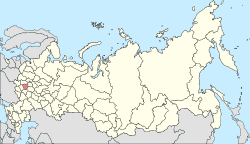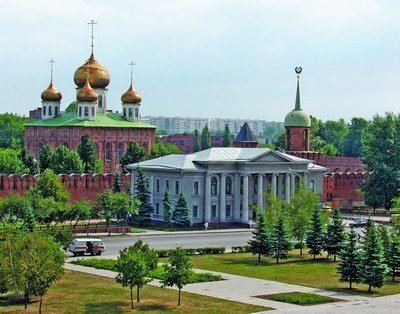Population 501,169 (2010) Mayor Yuri Tskipuri | ||
 | ||
Map of Tula, Russia
Tula (Russian: Тула; [ˈtulə]) is an industrial city and the administrative center of Tula Oblast, Russia, located 193 kilometers (120 mi) south of Moscow, on the Upa River. Population: 501,169 (2010 Census); 481,216 (2002 Census); 539,980 (1989 Census).
Contents
- Map of Tula Russia
- Russian tula sks
- Russian 1970 tula akm build combloc customs russian ak47
- Etymology
- History
- Administrative and municipal status
- Mayors
- Economy
- Culture
- Education
- Transportation
- Religion
- Sports
- Arts
- Public services
- Sciences technologies
- Others
- Climate
- Twin towns and sister cities
- References

Russian tula sks
Russian 1970 tula akm build combloc customs russian ak47
Etymology

The name of the city is of pre-Russian, probably Baltic, origin.
History

Tula was first mentioned in the Nikon Chronicle in 1146. As the chronicle was written in the 16th century, the date is disputed. The first confirmed mention of Tula dates to 1382.
In the Middle Ages, Tula was a minor fortress at the border of the Principality of Ryazan. As soon as it passed to the Grand Duchy of Moscow, a brick citadel, or kremlin, was constructed in 1514–1521. It was a key fortress of the Great Abatis Belt and successfully resisted a siege by the Tatars in 1552. In 1607, Ivan Bolotnikov and his supporters seized the citadel and withstood a four-months siege by the Tsar's army. In the 18th century, some parts of the kremlin walls were demolished. Despite its archaic appearance, the five-domed Assumption Cathedral in the kremlin was built as late as 1764.
In 1712, Tula was visited by Peter the Great, who commissioned the Demidov blacksmiths to build the first armament factory in Russia. Several decades later, Tula was turned by the Demidovs into the greatest ironworking center of Eastern Europe. The oldest museum in the city, showcasing the history of weapons, was inaugurated by the Demidovs in 1724, and Nicholas-Zaretsky Church in the city houses their family vault. The first factory to produce samovars industrially was also established there in the course of the 18th century. After the Demidovs moved the center of their manufacture to the Urals, Tula continued as a center of heavy industry, particularly in the manufacture of matériel.
In the 1890s, Ivan Savelyev, a medical orderly, became the founder of social democracy in Tula and set up a workers' study circle.
The city grew rapidly in the early 20th century as a result of arms production during the 1905 Russo-Japanese War and World War I. Tula's factories also manufactured weapons for the Red Army during the Russian Civil War of 1918–1921.
During the Great Patriotic War (World War II) of 1941–1945, the city was important in the production of armaments. Tula became the target of a German offensive to break Soviet resistance in the Moscow area between October 24 and December 5, 1941. The heavily fortified city held out, however, and Guderian's Second Panzer Army was stopped near Tula. The city secured the southern flank during the Battle of Moscow and the subsequent counter-offensive. Tula was awarded the title Hero City in 1976. It is home to the Klokovo air base and the Tula Arms Plant.
Administrative and municipal status
Tula serves as the administrative center of the oblast. Within the framework of administrative divisions, it is incorporated as Tula City Under Oblast Jurisdiction—an administrative unit with the status equal to that of the districts. As a municipal division, the territories of Tula City Under Oblast Jurisdiction and of Leninsky District are incorporated as Tula Urban Okrug.
Mayors
Economy
For more than four centuries Tula has been known as a center of crafts and metalworking. Tula is a developed industrial center. Importance in the industrial structure of Tula are metallurgy, machinery and metal with a high share of the military-industrial complex and food manufacturing.
Culture
A musical instrument, the Tula accordion, is named after the city, which is a center of manufacture for such instruments sold throughout Russia and the world. Tula is also renowned for traditional Russian pryaniki (gingerbread), cookies made with honey and spices (see Tula gingerbread). In the West, Tula is perhaps best known as the center of samovar production: the Russian equivalent of "coals to Newcastle" is "You don't take a samovar to Tula". (The saying is falsely ascribed to the writer and playwright Anton Chekhov, whose made a satirical portrait of one of his characters saying "Taking your wife to Paris is the same as taking your own samovar to Tula".)
The most popular tourist attraction in Tula Oblast is Yasnaya Polyana, the home and burial place of the writer Leo Tolstoy. It is situated 14 kilometres (9 miles) south-west of the city. It was here that Tolstoy wrote his celebrated novels War and Peace and Anna Karenina.
Education
Tula is home to:
Transportation
Since 1867, there has been a railway connection between Tula and Moscow. Tula is a major railway junction with trains to Moscow, Oryol, Kursk and Kaluga. The Moscow to Simferopol M2 motorway runs past the city. City transport is provided by trams, trolleybuses, buses, and marshrutkas. Tula trams, trolleybuses, and bus routes are operated by "Tulgorelectrotrans" (Tula city electrotransport company).
Religion
Most of Tula's churches are Russian Orthodox churches. Next in number are Protestants and Catholics. Non-Christian organizations that are present include Muslims, Jews, Hare Krishna, Buddhists and Taoists.
All Orthodox organizations in Tula and the Tula Oblast are included in the Diocese of Tula and Yefremov. Among the Tula Orthodox churches should be mentioned Saints Cathedral (1776-1800), the oldest church in Tula - Annunciation (1692) and the Assumption Cathedral of the Tula Kremlin (1762-1764). In Tula also Old Believers' community services which are performed in the church of St. John Chrysostom.
In Tula there is the only Catholic church in the area, the Holy Apostles Peter and Paul. Since the 1990s, Tula has several Protestant denominations, the largest church of which is a Baptist church with a prayer house in Tula. Representatives of other Protestant churches in Tula are Seventh-day Adventists, Presbyterians (Church of the Holy Trinity, The Glorious Jesus the Lord, the Good News), Pentecostals (Tula Christian Center, Church of the New Testament) and other evangelical churches (Word of Life, the Vine Gypsy Church).
Also the city has a synagogue and the Jewish Community House.
Sports
In Russian fist fighting, Tula was considered to have some of the most famous fighters.
The city association football club, FC Arsenal Tula, plays in the Russian Premier League in 2014/2015 and 2016/2017 seasons.
Arts
Public services
Sciences, technologies
Sports
Others
Climate
Tula has a humid continental climate. This is pronounced by warm summers and cold but not severe winters by Russian standards.
Twin towns and sister cities
Tula is twinned with:
